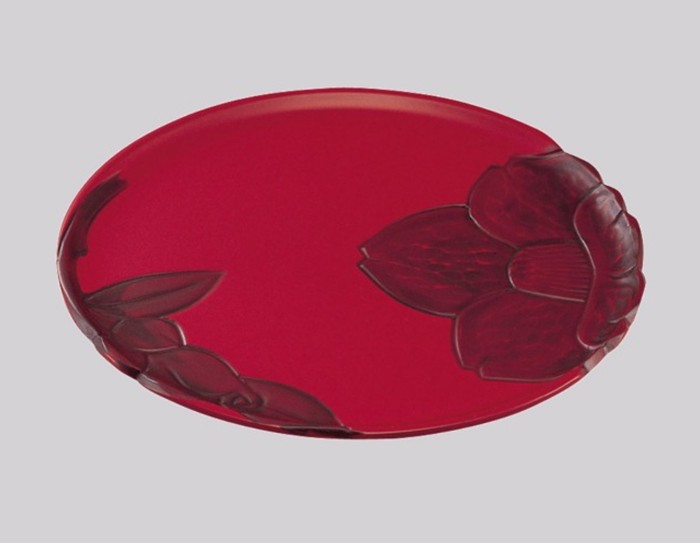Red & Black lacquerware collection SAZANKA CIRCLE
This remarkable item is hand-carved and individually crafted – each tray is one-of-a-kind. The wood of a Tochi tree (Japanese horse chestnut tree) is hollowed out in the shape of the tray and portions of the hand-carved Sazanka (“the flower of the autumn sun”) actually make up the handles. A sure conversation-starter, this tray is a marvelous addition to any home and makes a wonderful gift. Also included is a wooden stand giving you the option to proudly display your piece.
Details:
- Hand carved and crafted individually from the “Tochi” tree (Japanese horser chestnut tree)
- No two trays alike.
- Pattern shape is that of a “Sazanka” – an ornamental camellia known as the “flower of the autumn sun”
- Makes for a fine serving tray or placed as a decorative piece (stand sold separately)
- Wood base, hand painted and sprayed with a special lacquered paint from Takaoka, the second largest city in the Japanese prefecture of Toyama (traditionally known for its bronzeware).
- Light yet durable and strong – made to last for years
- Also included is a wooden stand giving you the option to proudly display your piece.
- Preferably hand wash only although dishwasher safe
- Do not microwave
- Diameter: 29.5cm (11.6″) ; Height: 2.0cm (0.8″) ; Weight 660g (23.2 ounces)
A word on Urushi
Japanese lacquerware, broadly known as “urushi” (pronounced “oorooshe”), is often red or black. The trademark Urushi deep black is achieved through a process that involves the use of iron powder. Pigments like vermillion are added to produce the classic vivid orange-red colour that was originally used to decorate pottery and preserve the bones of royalty.
Japanese lacquerware, broadly known as “urushi” (pronounced “oorooshe”), is often red or black. The trademark Urushi deep black is achieved through a process that involves the use of iron powder. Pigments like vermillion are added to produce the classic vivid orange-red colour that was originally used to decorate pottery and preserve the bones of royalty.
Black and red lacquerware is often decorated with “maki-e”; gold, silver or other coloured powders are sprinkled onto the wet urushi. In Japanese, maki means “sprinkling” and the “e” means “picture”. Thus, in combination, “sprinkling pictures”.
With origins that date back 9,000 years, Urushi is one of the world’s most durable natural lacquers. Urushi dries or hardens by absorbing moisture from the air. When hardened, urushi is waterproof, protecting objects from heat, salt, mould and all types of weather exposure.
Thanks to its magnificent, natural beauty and remarkable strength, Urushi has become an intrinsic symbol of Japanese culture.
Thanks to its magnificent, natural beauty and remarkable strength, Urushi has become an intrinsic symbol of Japanese culture.



